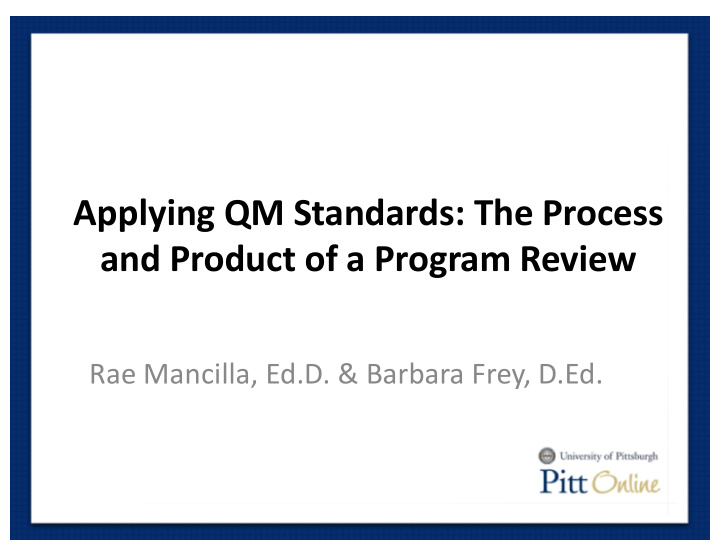



Applying QM Standards: The Process and Product of a Program Review Rae Mancilla, Ed.D. & Barbara Frey, D.Ed.
Agenda • Introductions • Program background • Review process • Report critique • Discussion • Q/A
Session Objectives • Identify the focus, criteria and data necessary to support your quality assurance effort. • Apply the steps of a QM-based program review to your institution. • Analyze the design, delivery, and impact of a program review and report.
Program vs. Course Review • What are the differences between program and course-level reviews?
Program vs. Course Comparison Similarities Differences Strives for continuous improvement Involves single/multiple courses Involves specific review criteria Involves single/multiple stakeholders Requires trained reviewer Focuses on achievement of course/broad program outcomes Involves considerable time commitment Considers only course-related data/multiple data sources Utilizes a third-party reviewer Utilizes a short/long-term timeline
QM Program Certification • 4 certifications • Online program design – Aligned with QM rubric – Minimum 3 years of data – Measurable program objectives – Curriculum alignment map – QM certified designers or faculty – Evidence of meeting QM standards – At least 3 courses
Online Design Unit • Pitt Online: – >10 years old – Graduate-level programs and certificates – 18 programs across 6 schools – Asynchronous and fully online courses – Centralized design and support unit – 1-1 faculty and instructional design collaboration – Early program assessment attempts abandoned
Review Process Assessed internal resources Established criteria for program inclusion Developed instrument to gather course data Completed and summarized course reviews Drafted report for design team feedback
Timeline of Events
Data Sources • Course review data – Learning objectives – Instructional alignment – Teaching and learning materials – Assessment techniques – Course activities and learner interaction • Faculty experience survey • Student experience survey • Program demographics/enrollment
Faculty Survey Example Pitt online provided an equivalent or better experience for my students than my face-to-face courses. 4% 24% 72% Agree Neither agree nor disagree Disagree
Student Survey Example
Data Sources Discussion • What data sources are readily available to you? • What data sources would be ideal for conducting a program review at your institution?
Report Format • QM headings • Program overview • Visualizations • Strengths • Recommendations for improvement • Exemplary practices across program • Summary of faculty and student experience • Conclusion and next steps • Glossary for online program directors
Critique and Discussion • Impressions and recommendations • How might these program review results be used by: – Faculty members? – Program administrators? – Online design units? • How can centralized design units provide feedback that may reflect negatively on their services to departments? • Questions?
Contact Info • Rae Mancilla, Senior Instructional Designer – RAM199@pitt.edu • Barbara Frey, Senior Instructional Designer – bafrey@pitt.edu
Recommend
More recommend